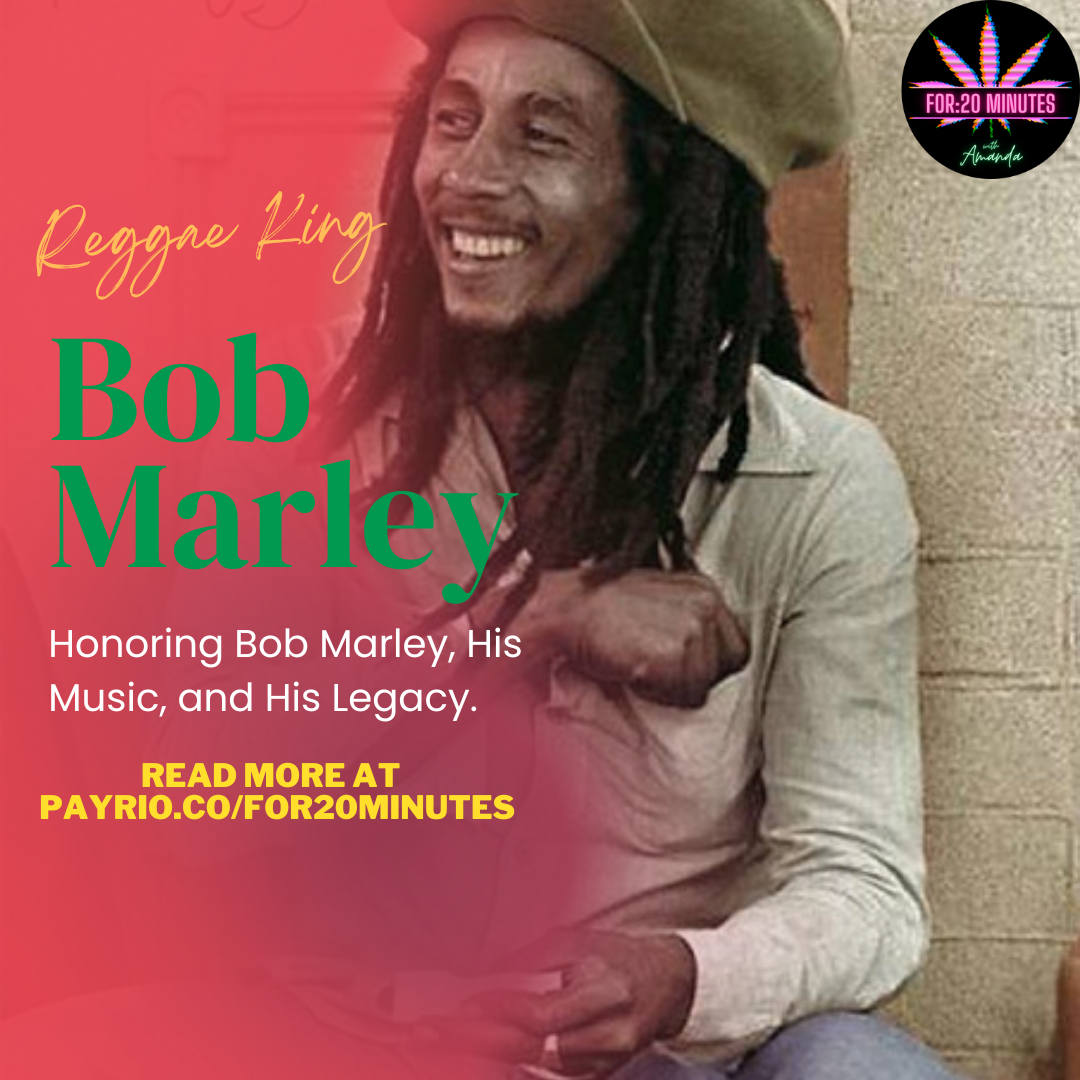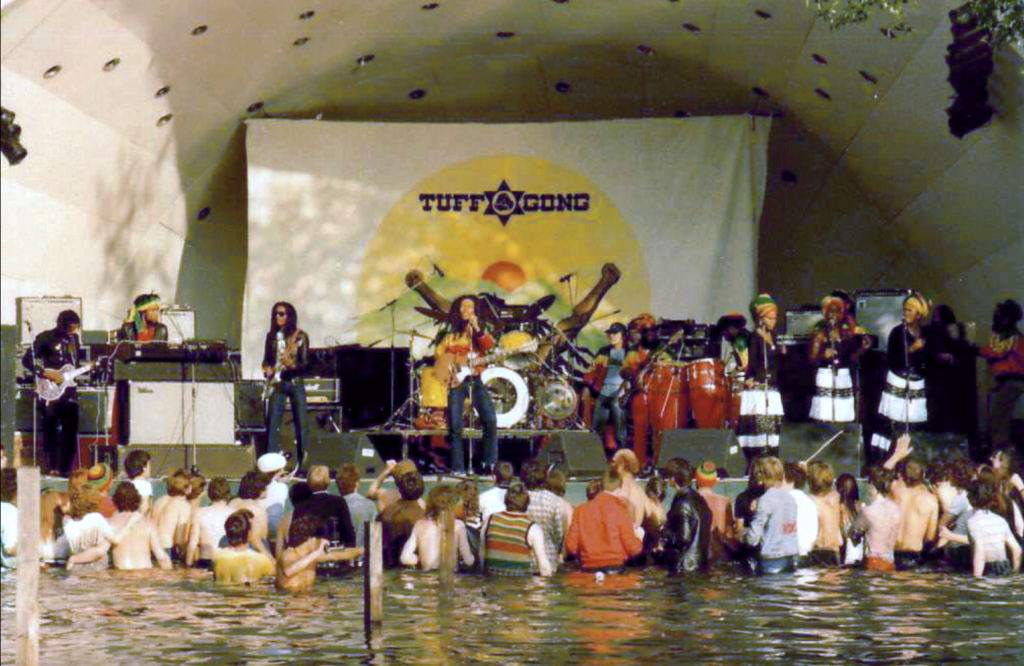
Honoring the King of Reggae: Bob Marley

The Greatness of a Man…
I couldn’t let February end without honoring the man who many consider to be the King of Reggae: Bob Marley. Born in February of 1945.
I first discovered my love for Marleys music during my teenage years… Sitting in a circle with my friends, passing blunts around, jamming out to Bob Marley & The Wailers. I remember the first song of his that I truly appreciated: “No Woman, No Cry”.
Now, don’t get me wrong, I had heard of Bob Marley and his music long before I was teenager. I grew up listening to a lot of different genres of music, Reggae included. But hearing Reggae music and really “listening to” and appreciating Reggae music, are two completely different things.
Bob Marley would later say: “Reggae is a vibration that you get from the earth, ya dig it. . . Reggae is different from all other type of music.”
When I started smoking cannabis, I gained a new appreciation for Reggae, and Bob Marley in particular. Not just for his music, but for who he was as a person. He spoke of peace, equality, spirituality, and how cannabis is an integral part in all of that. I don’t necessarily agree with EVERYTHING the man said or did, but his overall message is definitely one I can get behind…
“The greatness of a man is not in how much wealth he acquires, but in his integrity and his ability to affect those around him positively.”

Bob Marley & The Wailers
Robert “Bob” Nesta Marley was born February 6th, 1945 in Nine Mile, Saint Ann Parish, Jamaica. His Father, Norval Sinclair Marley, an Englishman from East Sussex, was 59 years old when he wed Bobs mother, 18 year old Sidilla Editha “Cedella” Malcolm. His father (who’s prominent family disinherited him after he married a black woman) unfortunately passed away from a heart attack when Bob was only 10 years old. A couple of years after his Fathers death, he and his Mother moved to Trenchtown, Kingston. What some would call a “slum” neighborhood.
There, Bob Marleys love for music would deepen. Ska, American R&B, and Folk-Calypso in particular would all have a huge impact on his own Reggae style.
He and his friends in Trenchtown formed a band, known by a few different names at first, but eventually landing on “The Wailers”. The original band-mates in 1963 were: Bob Marley, Bunny Wailer, Peter Tosh, Junior Braithewaite, Beverly Kelso, and Cherry Smith. But by 1966, the only original members left were Marley, Tosh, and Wailer. The Wailers would release a few hits together, including “Get Up, Stand Up”, “Simmer Down”, “Stir it Up”, and “I Shot the Sheriff”.
“I Shot the Sheriff” would famously go on to be recorded by guitar legend Eric Clapton in 1974. The popularity of Claptons version of the song would also help shine more light on Marley.
The Wailers disbanded in 1974, Peter Tosh, Bunny Wailer, and Bob Marley all going on to pursue solo careers.
Bob would continue to release albums under the name “Bob Marley and The Wailers” with a new backing band, and a group of back-up singers that included his wife, Rita Marley. The group would release several albums that included many timeless hits, such as “No Woman No Cry”, “Could You Be Loved”, “Three Little Birds”, “Buffalo Soldier”, and “Redemption Song.”
Marley was seen to his fans, and the people of Jamaica in particular, as a symbol of peace. He insisted on staying neutral when it came to politics. Not everyone would be happy about that, taking his neutrality as an endorsement for the People’s National Party, or PNP. This led to Marley, his wife Rita, and a few bandmates getting shot in an assassination attempt in 1976.
Jamaica’s political climate in the 70’s was quite volatile. Marley was scheduled to perform at the Smile Jamaica Concert. Two days before the concert, on December 3rd, 1976, Marley, his wife, and their bandmates were at Marleys house when multiple gunmen broke in and started shooting. There were no fatalities, but Rita Marley was shot in the head, and associates Don Taylor (manager), and Louis Griffiths were also shot. Bob himself took bullets to the chest and arm.
Even though he had been shot two days before, Bob still played the Smile Jamaica Concert. He agreed to play 1 song, but instead played a whole 90 minute set. Some of his bandmates were scared, and still in hiding, but Marley refused to hide. When asked why, he said:
“The people who are trying to make this world worse aren’t taking a day off. How can I?”

Gone Too Soon
In 1977, Bob Marley was diagnosed with an unusual type of skin cancer, Acral Lentiginous Melanoma. Unlike other forms of skin cancer that form in areas that see a lot of sun, AL Melanoma forms under your toenails, or on the soles of your feet. Places that often go unnoticed.
The cancer eventually spread to his brain, liver, and lungs. When he was close to the end, he attempted to fly home to Jamaica to pass away there. Unfortunately, his condition worsened quickly, forcing his plane to land in Miami, Florida. On May 11, 1981 he passed away there, with his family by his side.
Jamaica honored Marley with a grand State Funeral, and a Eulogy delivered by Jamaican Prime Minister Edward Seaga. Seaga said:
“Bob Marley was never seen. He was an experience which left an indelible imprint with each encounter. Such a man cannot be erased from the mind. He is part of the collective consciousness of the nation.”
He was laid to rest at a cathedral near his hometown of Nine Mile, with his guitar, a bible, and a stalk of the Ganja in his casket.
In 1993 Marleys Mother, Cedella Booker, created the 9 Mile Music Festival in his honor. The festival is held annually in Miami, and the admission fee includes a canned food donation, which they then donate to various Miami charities. Such an awesome way to honor a man who truly believed in loving your fellow man, and helping those in need.
Though he was popular and successful in life, he was even more so in death. The Legend album, released in 1984, was the best-selling Reggae album ever, selling over 12 million copies. He would go on to sell over 75 million records worldwide.
Bob Marley has been posthumously honored in many different ways, including being inducted into the Rock and Roll Hall of Fame in March of 1994, and having The Rolling Stone rank him #11 on their list of the 100 Greatest Artists of All Time.

Ganja: More Than a Plant
In 1960, Bob Marley was introduced to Rastafari, and began growing out his now infamous dreadlocks. I read a few different opinions on what exactly the dreadlocks represent to the Rasatafari, but the most common meaning I found was that they represent the Lion of Judah, found (sometimes) centered on the Ethiopian Flag.
His Rastafari beliefs were a huge part of Bob Marleys identity. Cannabis, also known to Rastas as “ganja” or the “holy herb”, plays a very important role in those beliefs. Marley (And most Rasatfari, though not all…) regarded cannabis as a Sacrament. An integral part in achieving a higher level of consciousness, while simultaneously grounding oneself. He was adamant that Ganja helps you meditate, allowing you to truly connect to yourself and to Jah (God).
And I have to say, I think he was right. I am not Raastafari, but I do use Ganja to ground myself everyday. My anxiety constantly makes my mind race, and my stomach hurt. Like, super nauseous, stabbing pain hurt… Cannabis calms my mind and my body down within minutes of sparking up. Literally minutes.
Pretty miraculous if you ask me…
In a 1975 interview with the Ann Arbor Suns Marc Gregory and Mike Dunitz, Marley elaborated on this belief. “Herb is natural. Herb is the healin’ of the nation. Everyone on earth is supposed to smoke herb. When you smoke it, we can see and talk real nice and get along. Now for some reason, some people feel, ‘No, these people shouldn’t smoke herb, because them gonna live too good, and then we no got no power. Ya dig it? God created herb for man… Let them tell me ‘don’t sniff hashish’ or ‘don’t take cocaine, great. But when they tell me ‘don’t smoke herb’, it come like it’s crazy, mad!”
You can find countless interviews where Bob talks about how beneficial he believed cannabis could be to society as a whole. As a way for people to connect with one another, and for its industrial uses. Clothes, energy, building materials, the list goes on… and Marley could tell you all about it. At this point, all most people knew about cannabis was that it got you high. Bob was ahead of his time.
Bob Marleys name will forever be associated with Cannabis use. It’s almost impossible to think of Marley and NOT think of rooms filled with Reggae music and Ganja smoke.
They go hand in hand.

Forever With Us
I’m personally so incredibly grateful for his music. I’m not joking when I say that I have often used his songs to calm myself in stressful situations…
True story: My son (who is 11 at the moment) loves Reggae. We live in a little beach town on the California coast, and I took him paddleboarding for the first time not long ago. He got a little scared as we were trying to paddle over the break… I could see him getting closer and closer to freaking out as my husband pulled his paddleboard farther out into the crashing waves.
So I started singing at the top of my lungs,
“Don’t worry, about a thing! Cuz every little thing, is gonna be alright!”
He got embarrassed and started with the “Moooommm, stop!”s, but he also started laughing. So I kept singing… And we got the paddleboards out to calmer waters.
I can’t tell you how much that moment meant to me, and Bob was right there with us.
Bob Marley may have left the physical world too soon, but if you love him like I do, he will always be with you.
Simply spark up some Ganja, turn on “Three Little Birds”, and he’s right there.
